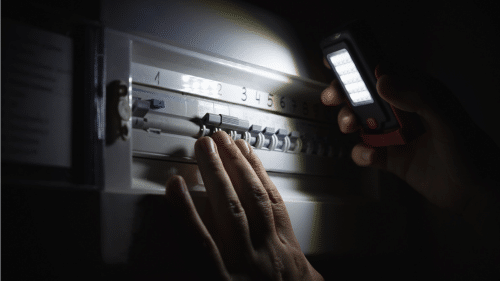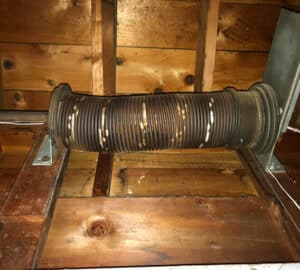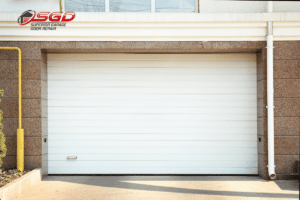Experiencing a power outage can be inconvenient, especially if it affects the functionality of your garage door. However, reconnecting your garage door after a power outage is a relatively straightforward process that can be done without professional help. In this guide, we will provide step-by-step instructions on how to troubleshoot and reconnect your garage door after a power outage.
Key Takeaways:
- Power outages can disrupt the functionality of garage doors.
- Understanding the impact of power loss on garage door openers is crucial for troubleshooting.
- Follow step-by-step instructions to reset the garage door opener and reconnect the door.
- Common issues that may arise during the reconnection process can be addressed with troubleshooting steps.
- Additional tips and considerations can help ensure a successful reconnection and prevent future power outage-related issues.
Understanding the Power Outage Effects on Garage Doors
Before attempting to reconnect your garage door, it’s important to understand how power outages can affect its functionality. Power outages can disrupt the normal operation of your garage door, causing it to malfunction or become completely unresponsive. In this section, we will explain the potential issues you may encounter and the impact of power loss on garage door openers.
During a power outage, your garage door opener relies on backup power sources, such as batteries or generator systems, to continue functioning. However, these backup systems may have limited power capacity or may not be properly maintained, leading to operational challenges. The lack of continuous power supply can result in various issues, including:
- Delay in response time when opening or closing the garage door
- Intermittent operation where the door stops or reverses unexpectedly
- Inability to open or close the garage door entirely
In addition to these immediate effects, prolonged power outages can place additional strain on the garage door opener’s components. When power is restored, the sudden surge can cause damage to sensitive electronic parts or motor circuitry.
It’s important to note that the specific impact of a power outage on your garage door may vary depending on the type of opener you have installed. Different models and brands may have unique functionalities and responses to power loss. Therefore, it’s crucial to consult the manufacturer’s guidelines or seek professional assistance to ensure the correct troubleshooting steps.
Understanding the power outage effects on your garage door is essential for successful reconnection and troubleshooting. By familiarizing yourself with these potential issues, you can take appropriate measures to resolve them effectively.
Troubleshooting Steps to Reconnect Garage Door After Power Outage
Follow these step-by-step troubleshooting instructions to reconnect your garage door after a power outage. This guide will walk you through the necessary actions to reset the garage door opener and address common issues that may arise during this process.
-
Check the Power Supply
Ensure that power has been fully restored after the outage. Verify that the circuit breaker or fuse for the garage door opener is intact and functioning properly.
-
Reconnect the Garage Door Opener
Locate the disconnect switch or rope that allows you to manually operate the garage door. It is usually found near the garage door opener motor unit. Pull down on the disconnect switch or rope to reconnect the opener to the door mechanism.
-
Perform a Garage Door Opener Reset
Most garage door openers have a reset button, usually located on the motor unit. Press and hold the reset button for approximately 10 seconds to initiate the reconnection process. Release the button once the lights on the garage door opener flash or a beep sound is heard.
-
Test the Garage Door
After completing the reset process, test the garage door by using the wall control or remote opener. Check if the door responds to the commands and operates smoothly. If the door still doesn’t function correctly, proceed to the next troubleshooting step.
-
Inspect Safety Sensors
Garage doors are equipped with safety sensors that detect any obstruction in the doorway. Check if the sensors are properly aligned and free from debris or dust. Clean the sensors and ensure they are facing each other without any obstruction.
-
Call a Professional
If the troubleshooting steps above do not resolve the issue, it is recommended to contact a professional garage door technician. They have the expertise and tools to diagnose and repair any underlying problems with the garage door opener.
By following these troubleshooting steps, you can successfully reconnect your garage door after a power outage and ensure its smooth operation. Remember to prioritize safety and consult a professional if you encounter any difficulties during the process.
| Common Issues | Troubleshooting Steps |
|---|---|
| Garage door not responding to commands | Check power supply, reconnect opener, perform reset, test door operation |
| Garage door opener lights not working | Verify power supply, reset opener, check for wiring issues |
| Garage door reversing immediately after closing | Inspect and clean safety sensors, adjust sensor alignment, check for obstructions in the doorway |
| Garage door unresponsive to remote opener | Replace remote battery, reprogram remote control, reset opener |
Additional Tips and Considerations
When your garage door won’t open after a power outage, it can be frustrating and inconvenient. In this section, we will provide you with some additional tips and considerations to help you reconnect your garage door opener successfully and avoid future power outage-related issues.
Common Reasons Why the Door Won’t Open
There are several common reasons why your garage door may not open after a power outage:
- Power surge: A power surge during the outage may have damaged the garage door opener.
- Power disruption: The power outage may have interrupted the communication between the garage door opener and the remote control.
- Motor overload: The power outage may have caused the garage door opener’s motor to overload.
- Safety sensor misalignment: The safety sensors may have become misaligned during the power outage, preventing the door from opening.
Troubleshooting the Garage Door Opener
If your garage door won’t open after a power outage, try the following troubleshooting steps before calling a professional:
- Check the power source: Ensure that the garage door opener is plugged in and receiving power. If necessary, reset the circuit breaker or replace blown fuses.
- Inspect the remote control: Replace the batteries in the remote control and check for any damage or malfunctions that may be preventing it from operating the garage door opener.
- Reset the opener: Consult your garage door opener’s manual for instructions on how to reset it after a power outage. This may involve pressing a specific combination of buttons or flipping a switch.
- Realign the safety sensors: Check if the safety sensors are properly aligned and clean. Adjust their position if needed to ensure they are facing each other and not obstructed by any objects.
If you’re unsure about any of these troubleshooting steps or if the issue persists, it’s always best to consult a professional garage door technician. They have the expertise and tools to diagnose and fix any underlying problems with your garage door opener.
Avoiding Future Power Outage-Related Issues
To minimize the chances of encountering garage door issues after a power outage, consider implementing the following preventive measures:
- Install a backup power source: Investing in a backup battery or generator can help ensure that your garage door opener remains operational during power outages.
- Maintain regular maintenance: Schedule regular maintenance for your garage door opener to keep it in optimal condition. This includes lubricating moving parts, tightening loose hardware, and inspecting for any potential issues.
- Consider a surge protector: Installing a surge protector can help protect your garage door opener from power surges during outages, reducing the risk of damage.
- Keep the manual on hand: Store the manual for your garage door opener in an easily accessible location so that you can reference it in case of emergencies or power outages.
By following these additional tips and considerations, you can increase the likelihood of a successful reconnection of your garage door opener after a power outage and minimize potential future issues.
Conclusion
Reconnecting your garage door after a power outage doesn’t have to be a daunting task. By following the steps outlined in this guide, you can quickly troubleshoot and resolve any issues, getting your garage door back to normal functionality.
It’s important to remember to prioritize safety throughout the process. Make sure to unplug the garage door opener before attempting any troubleshooting or reconnection. Additionally, if you encounter any difficulties or are unsure about any of the steps, it’s always a good idea to consult a professional for assistance.
Power outages can cause temporary disruptions to your garage door’s operation, but with the right knowledge and troubleshooting, you can easily get your door back on track. By understanding the effects of power loss on garage doors, following the troubleshooting steps, and considering additional tips and considerations, you can effectively reconnect your garage door and avoid future power outage-related issues.
FAQ
How do I reconnect my garage door after a power outage?
To reconnect your garage door after a power outage, follow these steps: 1. Locate the emergency release handle on the garage door opener. 2. Pull the emergency release handle down to disconnect the opener from the door. 3. Manually lift the garage door to the fully open position. 4. Slowly lower the door back down until it reaches the closed position. 5. Push the emergency release handle back up to reconnect the opener to the door. 6. Test the garage door opener to ensure it’s working properly.
Can a power outage affect the functionality of my garage door?
Yes, a power outage can affect the functionality of your garage door. When the power goes out, the garage door opener loses electrical power, which can result in the door not opening or closing automatically. Additionally, power surges caused by the restoration of power can damage the garage door opener or its circuitry.
What should I do if my garage door doesn’t open after a power outage?
If your garage door doesn’t open after a power outage, try the following troubleshooting steps: 1. Check the power source by ensuring the garage door opener is plugged in and the circuit breaker hasn’t tripped. 2. Inspect the emergency release handle to make sure it is fully engaged or disengaged from the opener. 3. Verify that the photoelectric sensors near the bottom of the garage door are unobstructed and properly aligned. 4. Reset the garage door opener by pressing the “Learn” or “Program” button, following the manufacturer’s instructions. 5. Test the door to see if it opens and closes properly.
Why won’t my garage door opener reconnect after a power outage?
There are several reasons why your garage door opener may not reconnect after a power outage. Some common causes include: – Faulty wiring or damaged circuitry in the opener. – An improperly engaged or disengaged emergency release handle. – Misaligned or obstructed photoelectric sensors. – A tripped circuit breaker or power surge damage. If none of the troubleshooting steps resolve the issue, it may be necessary to consult a professional garage door technician for further assistance.
Are there any additional tips to consider when reconnecting a garage door after a power outage?
Yes, here are some additional tips to ensure successful reconnection: – Always prioritize safety by disconnecting the power to the garage door opener before attempting any troubleshooting or repairs. – Consult the manufacturer’s manual or website for specific instructions on reconnecting the opener after a power outage. – Regularly inspect and maintain your garage door opener to minimize the chances of power outage-related issues. – Consider investing in a backup power source, such as a battery backup system, to prevent future disruptions due to power outages.








